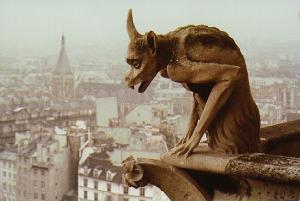Ominous and leering, ugly gargoyles were meant to drive away evil spirits, although one cannot deny that their presence may also meant to add to the mysticism that was religion.
Placed along the rooflines of buildings, each gargoyle’s location is explained by its function, that is, water spouts. If it rained, the water would travel through their bodies and drop onto people below as if spitting or drooling on them. Unfortunately, this convenient function has led to erosion and damage to many of the statues, and it is not uncommon for them to be replaced or recarved.
No two gargoyles are identical. Most come in the forms of mystical creatures, although the lion was particularly popular as well as human figures.
Although the exact purpose of gargoyles is not known, there are a few likely functions beyond serving as a gutter:
- Representation of devils and evil spirits bound to the church in retribution.
- Scaring away of devils, etc. to keep believers safe on the inside.
- Or, pure Medieval fascination with monsters.

